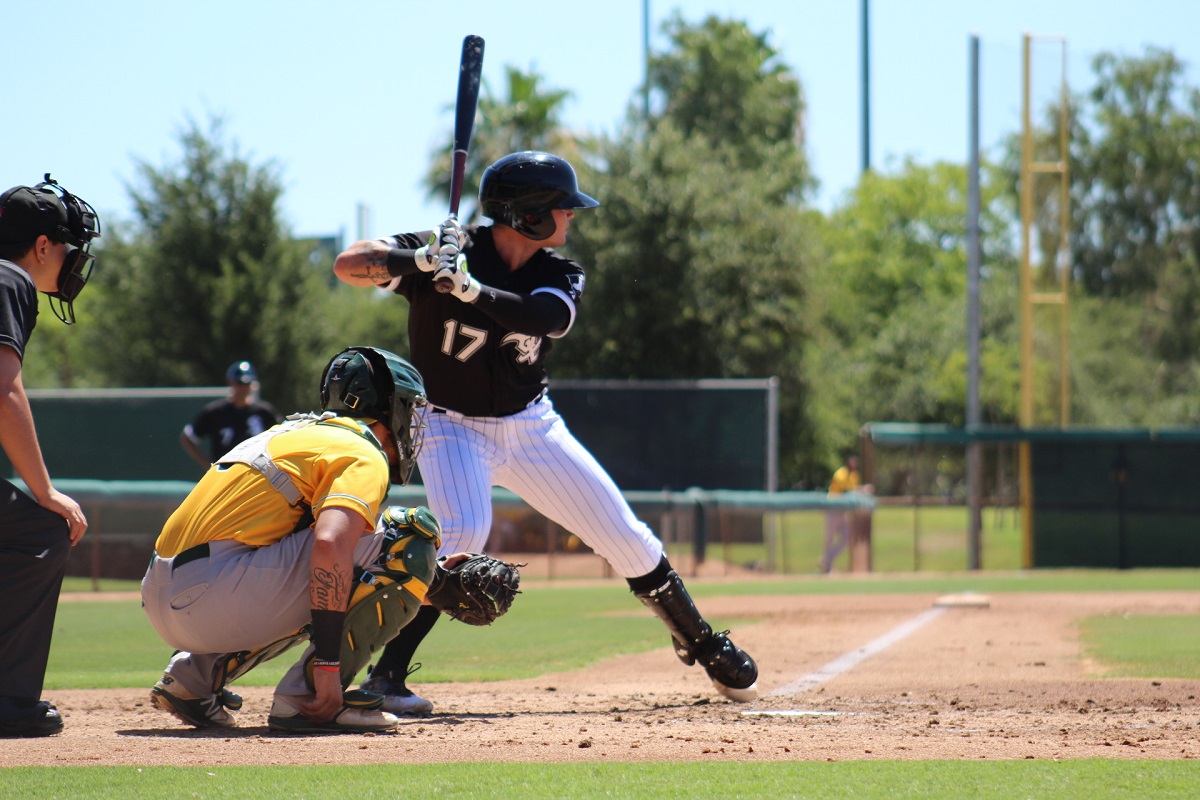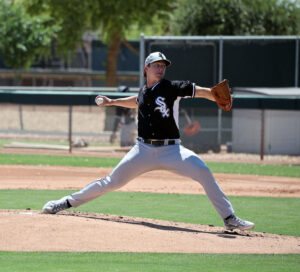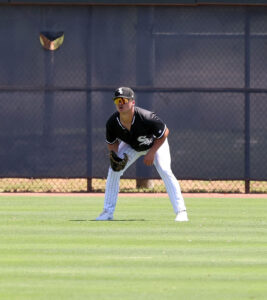Move to catcher paying off for late-round pick Tyler Osik

Keith Osik played in 456 games over the course of his ten-year major league career with the Pittsburgh Pirates, Milwaukee Brewers, Baltimore Orioles and Washington Nationals. The former 24th round selection was known as a defensive catcher. He compiled 1,200 plate appearances as a professional. He’s currently the head baseball coach at Farmingdale State College in New York. One thing the 52-year-old Port Washington native understands is the grind of becoming a professional ball player. That grind is the current battle his son Tyler is facing on his journey in the Chicago White Sox’s farm system.
“When I was a kid it was the coolest thing ever but I don’t remember a ton,” Tyler Osik said of being the son of a big leaguer. “I was so young so it’s just glimpses. It was like when I was born until I was 8 years old. I’m lucky to have him as a resource with hitting and everything since I’ve started taking it seriously.”
Osik spoke to FutureSox from Long Island near his parents’ home in between workouts in late December.
In the 27th round of the 2019 draft, the White Sox used their selection on the senior out of the University of Central Florida. The 5-foot-10, 203-pound slugger had given up on the draft after seeing players he felt were his equal flying off the board early on Day 3.
“My parents were watching the draft but after round 20, I pretty much gave up after I kept seeing dudes I thought I was better than going off the board,” Osik said. “I thought I was going to have to get a job honestly. Then luckily it happened. Someone wrote on my Instagram that I was drafted and that’s how I found out.
“I met with the White Sox area scout twice in Central Florida. I didn’t have a feel that they were going to pick me. I didn’t know who would pick me. I was well aware that I was a senior corner player and I just didn’t know where I’d go.”
What he didn’t know was that he was a target of former White Sox area scout Steve Nichols. Nichols recalled seeing Osik on numerous occasions when reached by phone in his home state of Florida.
“The apple doesn’t fall far from the tree and he’s definitely a blue-collar guy,” Nichols said. “He always swung the bat pretty good but he’s the type where you need to really see him a lot to appreciate his game. It really grows on you.”
The White Sox signed Osik for $2,500 and he quickly made the trek to the Arizona League to play rookie ball.
“They bounced him around all over the field at UCF, but he delivered offensively regardless,” Nichols said.
In 2018, Osik hit .310/.391/.485 with 9 homers and 56 RBIs. He came back in 2019 as a senior and hit 10 home runs while slashing .325/.410/.542 in 52 games. Prior to starring for the Knights, Osik played one season at Chipola College in Marianna, Fla., after starting his career at Division II Coker College.
He had a late start as it was as a junior college player, but then there was a major setback.
“When I was at Chipola College, I got in a collision,” Osik said. “My elbow hit a kid’s knee and that’s how it happened. It wasn’t from throwing.”
Osik tore the ulnar collateral ligament in his arm and was forced to have Tommy John surgery as a position player. The rehabilitation process isn’t as all-encompassing and stressful as it would be for a pitcher.
“I was ready to go in eight months,” Osik said. “It’s definitely different than being a pitcher. I was hitting four months after surgery.”
With his injury years behind him, Osik began his professional journey at Camelback Ranch in Glendale, Ariz. In 31 games, the 27th rounder hit .271/.346/.373 while driving in 18 in 133 plate appearances. The New York native played first base, designated hitter and some corner outfield during his first summer in pro ball. He was really struggling at the plate though at the outset.
“If you look at my numbers from college, I was a slow starter there as well,” Osik said. “I had lots of time off between my final college game and rookie ball. I went from a month off to facing high level velocity pitching right away in Arizona and it was tough.
“I think my timing was off. My first 50 at-bats were pretty bad.”
Through 14 games in Arizona, Osik was hitting .260/.362/.280. The on-base percentage was solid, but he had just one extra base hit, a double. Osik knew that he needed to do something with all of the talent around him and his spot in the organization appearing to be tenuous.
The White Sox were invested in giving as much playing time as possible to high school draft pick D.J. Gladney and Cuban teenager Bryan Ramos. Both are projected at third base, but they played first base and DH as well to get plate appearances. Further up the system, Andrew Vaughn is one of the very best corner prospects in the game. Gavin Sheets should reach Triple-A Charlotte this year and Jake Burger is healthy and ready to play affiliated baseball once again.
Two thoughts entered Osik’s mind as his career was flashing before his eyes. First, he reached out to an old friend that was in a similar position to get some advice on what the next step should be. Dylan Moore, a Seattle Mariners’ farmhand and former UCF Knight that has recently faced the grind of rookie ball, talked to Osik. He told Osik to hunt the mistake fastball and start getting the barrel out front to pull the ball. Osik was just trying to stay up the middle and put everything to the opposite field, but the results were not there.
“He gave me really good advice,” Tyler said.
The other thought that the senior signee had was that a position switch was in order to really enhance his chances at sticking around.
“I love baseball and want to play as long as I can,” Osik said. “After I got drafted last year, I kind of saw the writing on the wall. Andrew Vaughn went number one and plays first base, they already have Jose Abreu in the major leagues and corner outfield in this organization is swamped as well.
“So pretty much actually one month into rookie ball I was starting to get the hang of things and I mentioned (a position change) to some coaches.”
Nichols never saw Osik play catcher as an amateur at Chipola or Central Florida, but the veteran scout wasn’t surprised to hear that the position switch was in order.
“If he can stick back there defensively, he can turn himself into a player because I’ve always thought the bat could play,” Nichols said.
“I think catcher fits my skillset best as a player,” Osik said.
The recent addition to the organization took it upon himself to relay the message to field coordinator Doug Sisson and catching coordinator John Orton.
“I told John Orton and Doug Sisson that I’d be open to catching if you want to try me there,” Osik said. “I think they were still trying to get a feel for who I was as a player and a person.”
Osik started to hit better in Arizona. In his final 17 games in Arizona, Osik had seven multi-hit games and 10 extra base hits. The organization skipped him past advanced rookie Great Falls and sent him straight to Low-A Kannapolis to close out his draft year.
Osik had a really hot month in the South Atlantic League and Orton met with him to make the move to full-time catcher official. Over 108 plate appearances in 26 games, the righty popped five homers and drove in 19 runs. He hit .278/.352/.557 and posted a 160 wRC+.
“Once I got to Kannapolis, I kind of felt like I was in mid-season form again,” said the newly minted backstop.
It was a decision that has paid off in the short term and could continue to do so for the 2019 signee. After his first season, Osik was prepared to continue the ascent as a catching prospect in the organization and he got to work that winter.
“I went to a mini-camp last January 28 with Xavier Fernandez, Nate Nolan and Evan Skoug. We were there with 30 pitchers about a month before minor league spring training started,” Osik said.
Osik also got to dress for a couple big league spring training contests and witness firsthand how big leaguers get their work in.
Those opportunities ended up being short-lived, however, as COVID-19 was starting to ravage the country.
“Then we started up with minor league spring training,” Osik said. “We had a week and one intra-squad but then it got banged and I went home.”
Like many players in a similar boat, Osik wrestled with what to do next. He went to his parents’ home in New York, but ultimately decided to return to Florida to get some work in.
“I was in contact with my hitting coach from Kannapolis [Cole Armstrong] and our strength coach would reach out to ask what he had available to us,” Osik said. “I went to my college in Florida and lifted and worked out with the UCF team.”
Without an invitation to the alternate training site in Schaumburg, Ill., Osik was in contact with White Sox coaches and instructors. He was mostly working on his own to get better in advance of the 2021 season. Bouncing back and forth between Florida and New York wasn’t an issue and the catcher didn’t have any problems following through with his workouts.
Osik flew to Arizona to participate in fall instructional league with the White Sox. Jim Callis of MLB.com detailed some of that experience with quotes from Chris Getz on the transition to catching. He was joined by Carlos Perez and Jefferson Mendoza on that instructs roster and the experience was very helpful for Osik. He was able to catch recent prep selections Jared Kelley, Matthew Thompson and Andrew Dalquist. Osik also caught Kade McClure and raved about the new life on his fastball. Avery Weems was an instructional league standout as well, according to Osik, and he wasn’t surprised that another team worked to get him.
The changes to the offensive infrastructure were very apparent as well with constant dialogue from biomechanical engineer Ben Hansen and hitting coordinator Ben Broussard.
“I definitely noticed it,” Osik said. “Especially at instructs. Ryan [Johansen] and Ben have done a great job with all of us. I send Ryan videos of certain things I’m working on and he’s always there to help.”
While working hard to achieve his dream, Osik was able to admire some of his organizational mates and take it all in as well. He surmised that Burger looked “all the way back” and noted that he was “the best player at instructs and it really wasn’t close.” Infielders Jose Rodriguez and Gladney were given praise as well as a mention for Osik’s buddy and recent teammate Chase Krogman as an outfielder.
In regards to the 2021 minor league season, Osik is all about controlling what he can control.
“I don’t care where I start, I just need to get at-bats and play,” he said.
Whether it ends up being back in Kannapolis or the possibility of a promotion to the Carolina League with the Winston-Salem Dash, the 24-year-old will be ready to seize his opportunity.
White Sox minor league players are under the impression that they won’t report to spring training until the major league portion is completed. They’ve been in contact with coaches and the dialogue will continue. There isn’t much margin for error for college seniors taken in the 27th round. As a first baseman, the bat is very much the primary carrying tool and Osik did something about it. The move to catcher gives him a chance at a big league future. He’s controlling what he can control and looking forward to continuing that growth on a minor league field this summer.
Want to know right away when we publish a new article? Type your email address in the box on the right-side bar (or at the bottom on a mobile device) and click create subscription. Our list is completely spam free, and you can opt out at any time. Also, consider supporting FutureSox on Patreon! You can get early access to special articles and Patreon-only posts, in addition to more benefits.
Shop our exclusive merchandise! Show your support with FutureSox apparel.







1 thought on “Move to catcher paying off for late-round pick Tyler Osik”
Comments are closed.